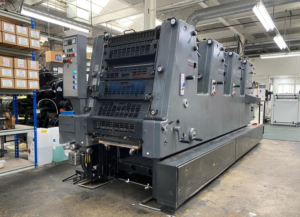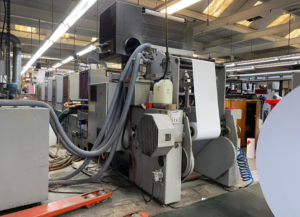Colour-changing ink is one of the most powerful technologies developed to combat fraud and counterfeiting.
The innovation of invisible ink, or security ink can be dated back to the mid 1500’s, when Italian polymath Giovanni Battista della Porta created the first sympathetic ink by using alum and vinegar and coded secret messages into eggs, which would then reveal themselves once boiled.
The concept behind covert printing methods has remained the same; to ensure security, confidentiality, and authentication in communication and document protection. Over the centuries, invisible ink technology has evolved significantly, expanding from simple organic compounds to sophisticated chemical and UV-reactive formulations used in modern security printing.
With Security Ink being one of the most effective and trusted ways to ensure protection and validity with documents, it has developed in many ways and taken on different forms over the years.
Thermochromic and Photochromic Ink
Both of these security inks share a core function – they respond to external stimuli to reveal information.
Thermochromic ink changes colour when exposed to temperature variations, making it an effective security measure for documents, tickets, and product authentication. Companies first utilised this kind of ink during the 1970s with novelty items such as mood rings and other colour-changing toys. However, today, this ink creates bespoke security features on physical documents, adding an extra layer of protection.
Photochromic ink, on the other hand, reacts to UV light, temporarily altering its colour and offering an additional verification layer for secure documents. We print this ink onto documents such as passports, banknotes, and driver’s licenses, where it commonly reveals hidden logos or text.
It’s important to note that each of these inks will temporarily become visible (photochromic), or change colour (thermochromic) when exposed to their respective stimuli before returning to their original state, typically within a minute or two.
The Science
Thermochromic ink works the way it does because of a chemical reaction. This ink is most commonly made up of leuco dyes, a type of dye that can be switched between two chemical forms when influenced by outside stimuli. Once heated, thermochromic ink reacts and shifts chemically, then returns to its original state upon cooling. The nature of this shift is what makes this ink so unique and effective for security applications.
The science behind photochromatic ink is similar to thermochromic ink; it is consisted of a type of dye that has two shifting chemical states. When you shine UV light over this ink, it will then reveal itself and the hidden logo or text will be fully visible in daylight. This is because UV energy breaks certain chemical bonds and the dye molecules inside photochromic ink undergo a structural transformation, absorbing visible light and reflecting it in a way that produces the coloured effect. Just like thermochromic ink, this ink also slowly returns to its original, invisible state after the external stimulus has been removed.
How are these inks printed?
We print these inks lithographically using specialist printing equipment. Zunoma regularly prints both security inks with our Heidelberg GTO and Muller Martini Concept, renowned for their industrial ability.


Left: Heidelberg GTO. Right: Muller Martini Concept.
Unlike standard inks, thermochromic and photochromic inks require careful handling to ensure their reactive properties remain intact throughout the document’s lifespan.
Where do we usually see these inks?
Whilst the level of security and the document’s role determine the necessary security features, we can observe several examples of thermochromic and photochromic ink appearing in official documents over the years.
Passports: Modern passports, such as those issued by Austria and Finland in 2023, include images printed with thermochromic ink on their data pages.
Banknotes: Some currencies incorporate thermochromic features that change colour with temperature variations, serving as an anti-counterfeiting measure.
ID Cards: Certain identification documents, like the ID card of Georgia issued in 2011, feature thermochromic elements that enhance security.
Event Tickets: We apply thermochromic inks to event tickets to prevent duplication and ensure authenticity.
Pros and Cons of these inks.
Let’s go over some of the pros and cons of both inks. It’s important to remember that whilst both are effective at ensuring protection, some can suit some jobs better than others.
Thermochromic Ink:
Pros:
- Enhanced Security: Adds an interactive authentication layer to documents.
- Reversible Effect: Returns to its original state after cooling, allowing repeated verification.
- Versatile Applications: Used in banknotes, passports, tickets, and product packaging.
- Customisable: You can customise it to specific security needs with different temperature thresholds and colours.
Cons:
- Durability Concerns: Prolonged exposure to heat can degrade the ink over time.
- Limited Visibility in Extreme Temperatures: If stored in very hot or cold environments, the ink may not function correctly.
Photochromic Ink:
Pros:
- UV-Based Authentication: Provides an additional security feature visible under UV light.
- Difficult to Replicate: Counterfeiters find it challenging to reproduce accurately. Additionally, only specialised companies can sell this type of ink, making it extremely difficult to acquire without specific accreditations.
- Suitable for Various Documents: Commonly used in passports, ID cards, and high-security labels.
Cons:
- Dependent on UV Light: Does not function in low-light or indoor environments.
The Future of Security Inks
At Zunoma, we advance security printing by integrating cutting-edge ink technologies into our solutions. By leveraging our expertise and industry-leading printing equipment, we help businesses and governments safeguard their most critical documents.
If you found this blog useful or have any questions, feel free to contact us here.

Louis oversees press production, optimizing performance and leading a skilled team of Press Operators. Focused on innovation and continuous improvement, he drives efficient, cost-effective operations while enhancing service capabilities and speed.